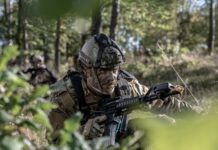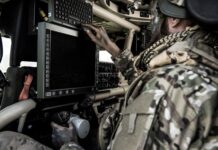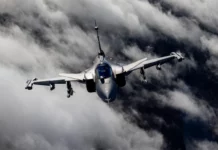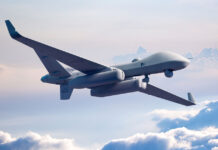The Swedish Air Force (SwAF) accepted into operational service its first Saab Gripen E fighter on 20 October 2025 during an event at the base of its Skaraborg Wing (F7), located at Såtenäs in southwest Sweden.
The event was attended by Swedish Defence Minister Pål Jonson, who stated on his X social media account on 20 October, “On site at F7 Såtenäs, where the Swedish Armed Forces today receive the first of 60 JAS Gripen E aircraft. It is an important day for the Air Force and the Swedish Armed Forces. Gripen E is an example of cutting-edge Swedish technology and is a modern fighter aircraft that is essentially completely new.”
A prototype Gripen E made its maiden flight on 15 June 2017, with a first production-standard aircraft then flying for the first time on 3 December 2019. Since then the type has been flown by the SwAF’s test and evaluation units, initially out of Saab’s Linköping site and then also the SwAF’s air base at Malmen (there is also a Gripen Flight Test Center in Brazil, where Gripen Es and Fs are produced under licence).
Powered by a single GE F414-GE39E afterburning tubofan offering 64 kN of thrust (98 kN with afterburner), the Gripen E has a maximum speed of 2,100 km/h at 15,240 m, a service ceiling of 52,000 ft (6,000 m), a combat range of 1,500 km and a ferry range of 4,000 km. The aircraft is equipped with the Leonardo PS-05/A Raven active electronically scanned-array radar, the Leonardo SkyWard infra-red search and track (IRST) system, and Saab’s Arexis electronic warfare and self-protection suite.
The Gripen E also has advanced human/machine collaboration (HMC) features, including a wide area display in the cockpit, and in May 2025 achieved a first by being flown with German defence technology company Helsing’s Centaur artificial intelligence (AI) agent in control of the aircraft.
The Gripen E has 10 hardpoints for weapon carriage and all SwAF Gripens, including its current C/D models, include MBDA Meteor beyond-visual-range air-to-air missiles and Taurus KEPD 350 air-launched cruise missiles among their weapon inventories.
While a total of 60 Gripen Es are on order for the SwAF, it currently retains a fleet of 71 Gripen Cs and 23 Gripen Ds. When the Swedish government decided in February 2013 to acquire 60 next-generation Gripens, the original plan was to achieve this through upgrading Gripen C/Ds. However, it was subsequently decided that the Gripen C/Ds would be retained to preserve the combat mass of the SwAF, while the Gripen Es would be new-build aircraft.
In April 2022 the Swedish defence procurement agency (FMV) announced that all of the SwAF’s Gripen C/Ds would be upgraded to keep them operationally relevant until 2035. Forty Gripen C/Ds are to be retained by the SwAF once the 60 Gripen Es have entered service, for a total fleet of 100 Gripens altogether.
On 20 October Jonson additionally stated on X, “I look forward to seeing more JAS Gripen E aircraft joining the Air Force in the future. Parallel to the introduction of Gripen E, studies are underway to prepare for the next generation of fighter aircraft. Foreign interest and major investments in research will enable further successes in the aviation sector in the future.”
With regard to what will come after the Gripen E, Sweden has yet to make up its mind. Saab is obviously keen to develop a next-generation fighter and candidly the SwAF is also keen to see that happen, but the Swedish FMV continues to weigh the pros and cons of embarking on such a plan.
Although Sweden signed a memorandum of understanding with the UK on 19 July to work on concepts for what was then the Tempest sixth-generation fighter programme, the development of the Gripen E at the time meant the timing of a Swedish future fighter requirement was not a good fit for the Tempest programme. Ultimately, therefore, Sweden did not join this sixth-generation fighter effort and the UK, Italy and Japan went ahead as partners on what became the Global Combat Air Programme (GCAP).













